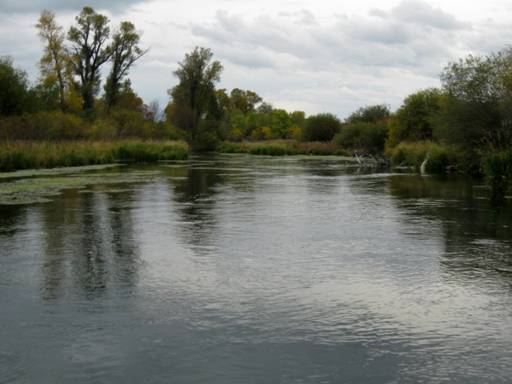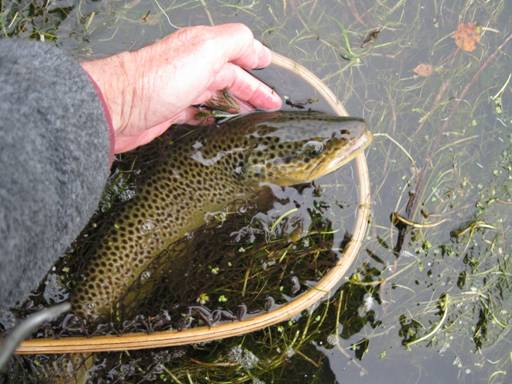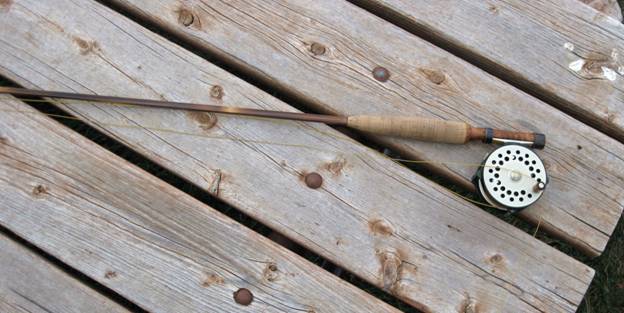FALL FISHING
Most outdoor activities are driven by the seasons, and fly fishing is especially oriented by seasonal changes. Two seasonal changes, from winter to spring and summer to fall; have the most marked effect on the fly fisher, and while there are changes between spring to summer and fall to winter they are not as significant.

One of my favorite seasons in the Rocky Mountain region is the fall. The hot oppressive dog days of August are soon replaced by the crystal clear days and refreshingly cool nights of September and October. Usually by mid-September there is a fresh dusting of snow on the highest peaks and the geese are beginning to gather and fill the early mornings with the music of fall.
On our local trout waters the decreasing day length and cooler water temperatures are stirring the trout out of their summer lethargy. Brown trout are beginning to move toward their spawning areas and the rainbows and cutthroats are anxious to take advantage of the final hatches of aquatic insects and the abundance of late season terrestrials. It's a magical time.
One of my favorite hatches is the fall Baetis; commonly referred to as Blue-winged Olives [BWO] or simply Olives. It's interesting that in many places in the west the Baetis hatches mark the beginning of the mayfly hatches in the spring and they mark the end of the mayfly hatches on many waters in the fall. The only thing that makes fishing Baetis hatches less than optimal is the weather. Spring and fall Baetis prefer to hatch when the weather is overcast and spitting snow or misting rain. You might see a smattering of flies hatching on a clear sunny day but they hatch in earnest and the trout eat them with greater relish when the weather is more on the nasty side.
While you can find fall Baetis hatches on most of our trout waters in the west some of the most prolific hatches are found on the big tail-water rivers like the Big Horn and the Missouri, and the various spring creeks.
Spring and fall Baetis are refined hatchers. They don't require you to get up at the crack of dawn and they don't keep you until the sun has dropped behind the western hills. You can sleep in and enjoy a good breakfast, linger over a second cup of coffee, and you can make dinner reservations at your favorite restaurant at a reasonable hour without worrying that you will have to leave the stream before the hatch is done.
I generally like to arrive on the stream shortly after noon when I'm looking for fall Baetis. Over the many falls that I have fished this hatch I have several places where I am relatively certain that I can find flies hatching and trout ready to eat them. I like to have a thermos of hot coffee and a light weight pair of binoculars when I'm scouting the water looking for hatching fall Baetis. The hot coffee helps to take the edge off the cool weather, and the binoculars not only help me spot rising fish but allow me to enjoy the migrating fall warblers and other birds that are common along most riparian areas during the fall.
If I want to start fishing before the actually hatch starts or during the beginning of the hatch before the trout begin to key on the hatching flies I will start out by fishing a nymph. I like the Sawyer Pheasant-tail as an imitation for the Baetis nymph. Sometimes I use the traditional pattern and other times I use a flash-back variation or even a traditional pattern tied with a tuft of marabou tied over the thorax to imitate emerging wings. These flies I fish upstream or up and across and occasionally I add a little motion by twitching them slightly. Baetis nymphs are good swimmers and a slight twitch will often bring strikes when the trout are ignoring dead drifted flies. In addition I sometimes employ the Leisenring lift by drifting a weighted nymph through the channels between the weed beds and then lifting the rod tip to cause the nymph to lift toward the surface where I think a trout might just be watching for an emerging mayfly.
However, my favorite Baetis fishing is when the trout are keying on the emerging and fully emerged flies. I like to use a parachute pattern or a Comparadun pattern for my dry fly and then I trail an emerger off the bend of the hook. I keep the dropper short; 6 to 10 inches behind the dry fly usually seems to work best for me when the trout are keying on the emerging fly. There are several flies that you can use as a dropper; an RS-2 is a popular pattern or the WD-40 is another good choice. Like all imitative patterns you should try to match the color of the insects that hatch on your water. I try to have several colors from light to dark olive to cover the various shades of color that I might encounter. Our fall Baetis tend to be on small size, and I often find it necessary to use a size #22 to be close to the size of the naturals.
I like a low floating imitation for an adult imitation so I generally reach for a parachute pattern. I attach a short – 8 to 10 inch – piece of leader material to the bend of my dry fly imitation and trail an emerger behind the dry. I will experiment with the length of the dropper and substitute a nymph for the emerger until I'm satisfied that I am offering the fish what they are looking for. When I have the combination correct I concentrate on fishing for the larger fish that are rising.

Fall brown that ate my Baetis imitation
When I'm fishing on the smooth currents of the spring creeks or on the big tail-water streams where the weed beds create a mix of conflicting currents that can cause my fly to act unnaturally if it float too far I try to place my fly very close to the rising fish. I wade as close as possible to the feeding fish keeping a low profile and moving slowly until I am in position to make a short accurate cast. If the fish does not take my imitation I allow the fly to float well passed the feeding fish before I pick up my fly for another cast. I'm careful not to cast directly over the fish, and if possible I try to stand just below and off to one side from the rising fish. This allows me to use a curve cast that keeps the leader off to one side of the fish. It's always a thrill to see a big nose poke up through the surface film and confidently sip in your imitation like it was a natural insect.

7½ foot, 5 weight Kusse Quad Bamboo, Hardy Bougle Reel and 5 weight Phoenix Silk Line
At least one day during the fall Baetis fishing I like to break out a bamboo rod and a traditional silk line. It's just a tradition that I enjoy and it seems a fitting way to close out the season before the last major mayfly hatch ends for the season. It's a blessing to own a fine rod handmade by one of America's premier fly rod makers.
Whatever equipment that you use be prepared for the weather. I always carry an extra sweater, gloves, a stocking cap and a good rain jacket when I am out looking for fall Baetis. When I find hatching flies and feeding trout I don't want the weather to cut my day short.
Fall Baetis often provides me with some of the trout fishing of the season. The fish are fat, the fall colors are beautiful, and if I have the right combination of flies and skill it is always a memorable day.
